2015-06-14By Murielle Delaporte
After graduating from the Naval Academy in 1986, Commander Peter A.J. Bergen Henegouwen served for six years mainly on minesweepers and minehunters.
This included a deployment for clearing sea mines in the Persian Gulf in 1991 as executive officer on HNLMS Haarlem.
In 1996 Commander Bergen Henegouwen received his first command on board of the minesweeper HNLMS Naarden.
He was then in command of the minehunters HNLMS Delfzijl and HNLMS Hellevoetsluis, which was assigned to the MCM flotilla “MCMFORNORTH” (now SNMCMG1).
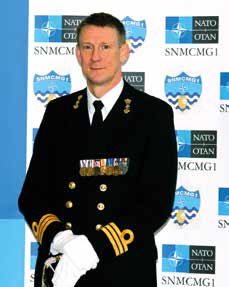
In March 2011, his previous assignment was at the Netherlands Maritime Forces (NLMARFOR), Maritime Battle Staff, where Commander Bergen Henegouwen assumed responsibilities on the deployments with other international task groups.
Commander Bergen Henegouwen is the Commanding Officer of the Standing NATO Mine Countermeasures Group 1 (SNMCMG 1) since January 22nd, 2015, a Group currently composed of German, British, Belgian, Dutch, Polish and Norwegian Mine countermeasures vessels, as well as a German Command and Supply ship.
One of the particularity of this Group is the fact that its Commander sails on a ship from another nationality than his, which happens from time to time, but is rather uncommon.
In the interview below done after the first week of sailing as a Group of four ships – the Flagship FGS Donau, the BNS Lobelia, the FGS Auerbach and the HMS Pembroke -, he describes the challenges, but also the excitement, of commanding an international staff on the German Tender Donau.
He also explains his roadmap for the Group leading towards Trident Juncture 2015, the largest NATO exercise organized in decades to take place in the Fall in Southern Europe, which envisions a better integration and synergy of MCM tasks within the overall fleets.
It seems Joint Warrior 2015, which took place in April, off the Scottish shores, already started to fulfil such a wish…
Commander, what are the missions of the SNMCMG1 for the months to come?
We have quite a busy program planned for this upcoming six months period: in addition to doing historic ordnance clearance, HOD for “Historic Ordnance Disposal” as we call it, off the coasts of Estonia, Belgium and the Netherlands, as well as France, we are participating to five different exercises.
When we first started to sail together in January, I was very pleased to see that all the ships got out at the same time without incident, as, in my experience commanding similar ABNL deployments over the past three years, breakdowns often occur given the age of most mine-countermeasure vessels.
We always manage to keep them going, but delays for repair as you leave harbor frequently happen.[ref] ABNL stands for « Admiral BENELUX », which is the Common Operational Headquarters for the Netherlands and Belgium Navies. These headquarters are located in Den Helder in the Netherlands.[/ref]
This shows that units and ships were individually well prepared to work in this group.
The initial focus of the first three weeks on board is mostly about “getting used to work together”, because although the ships are individually well trained, they might lack some experience in working together.
It is all about different cultures, different procedures; some nations may allow certain things other nations do not, so we have to get used to each other and see how to manoeuver and do our exercises as safely as possible.
That is basically what we do at the beginning of a deployment: we start with communication exercises, maneuvering exercises, such as replenishment at sea (RAS), which is especially important.
As you come into close quarters, you want to see how the other ships behave in different types of weather.
These are the basics to ensure safety as we do our drills and exercises.
The next focus is to test our operational capabilities, i.e. mine countermeasures (MCM) and be prepared for joint exercises, the two main ones being Joint Warrior in March and Baltops in June.
We also organize our own sets of exercises, such as a two week-training period in the North Sea and an exercise off the Dutch coast.
We also join forces with exercises organized by other navies in the area, such as the Lithuanian Navy.
The command and support staff of the Group are from different nationalities than the ship hosting them: a German ship with a German crew hosting a Command staff composed of Dutch, Belgian and Spanish officers and headed by a Dutch CO.
What are the challenges of operating on such an international ship and commanding a group of ships from Germany, the Netherlands, Belgium and the UK?[ref] A Dutch, a Polish and a Norwegian ships joined the group after the interview was concluded.[/ref]
How different is it for you compared with your previous commanding experiences?
The nations provide the ships to the Group and it is their national responsibility to be operationally ready.
In the workup phase, the only thing I am doing is getting the ships to learn how to work together, how to communicate, how to maneuver at the same time, and, of course, keep up their operational readiness to be able to act if “something real world” happens.
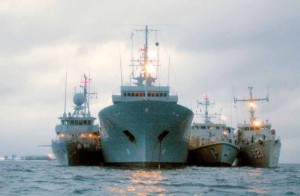
Ever since we have been at sea, you might not see it, but I am walking around with a smile on my face twenty-four hours a day.
I am enjoying it as, I believe, do the crews of all these ships, because being in this group means meeting colleagues from other nations and learning from each other.
As for me, personally, the only change is whom I am reporting to. In my previous assignment, I organized deployments for ABNL ships, as well as other ships.
I cooperated for instance with Danish or Norwegian staff, who would augment my staff and vice versa.
I worked with the Danish, German and Belgian MCM fleet and navies.
Because of my own deployments for the ABNL HQ, I hence do have some international experience.
The only change now is, of course, that I am working for NATO and reporting to the UK-based Maritime Command (MARCOM), in addition to my national authorities.
It is indeed a different process of reporting, but I am doing the same kind of work.
The main role of my staff is to act as a tasking authority, and, whether we do that nationally or within NATO, we all use NATO procedures.
You cannot obviously use the latter outside of NATO, as was the case for my staff and me in a recent international exercise last October in the Arabian Gulf, to which participated more than 20 countries.
It then becomes very challenging: you have to find out how to do your procedures, without using confidential procedures, nor NATO ones, which you are used to, and how to talk to each other in technical language.
However, these kinds of new challenges show that we are quite capable of doing this.
Sailors at sea all know what starboard or forward mean.
The language of the sea is universal.
We all know what sailing at sea means, we all go through the same environment, and we all speak English, somehow!…
So we find ways to communicate and, as long as you can communicate, you can work together.
There is always something to do for the staff: whether preparing for the next port visit or planning our exercises.
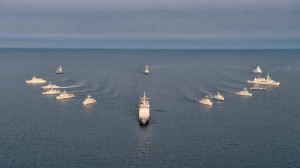
We are basically using the Donau as a supply ship, so we are trying to get everything for the group such as food or fuel.
This ship could almost go around the world with its fuel supply, but most of the mine-hunters have a two-week fuel autonomy.
Some of them, like the Norwegian mine hunters have an hover-craft capability, which consumes quite a lot of fuel, so they need to refuel every other day.
The need for a supply ship capable of providing fuel, like this German ship, is even more important for these kinds of mine-hunters, as you cannot hunt mines, while having to go back to port every other day.
All NATO ships use the same fuel (F76) and can handle the same naval diesel oil for helicopters.
Such standardization and the ability to take fuel from every supply ship, wherever it is, is one of the good things in NATO.
The billing is done by each nation and it is a very good system.
Two-week autonomy is also a good length as far as the crews are concerned, as they are rather small and need to sustain a high level of concentration in their work.
Our port visits are therefore as much intended to show the NATO flag as to provide the crews with R&R [Rest and Recreation], but if we had to extent our deployments at sea beyond two weeks, we would of course do our job.
The downside of that, as I stated, most of our MCMVs [Mine Counter-Measures Vessels] are getting older and during a period of two weeks of operations, they will have some defects in some way.
If the crews are not capable of repairing their own equipment, we are depending on shore assistance.
Each nation has indeed various levels of readiness, but in this Group, the equipment onboard each ship seems comparable.
Is there an “ideal Group” from your standpoint as far as its composition is concerned and how do you adjust to potential interoperability issues?
Logistically, it would be very nice to have all the same ships, so we could always have a 100% operational readiness.
However – and that is a big “however,” MCM is a very difficult type of warfare, since we are searching for small objects on the sea bottom, while conditions are not always that favorable.
If you have a clear sandy bottom and you put a soda can on top of it, most of our mine hunters will find it.
In 90% of the cases unfortunately, it is not that easy.
There are rocks on the bottom, or, if there is indeed a sandy bottom, it is in constant motion like dunes. In the coastal area, you face a lot of mud in which objects tend to sink.
So finding sea mines is not always easy.
The only way to go around these difficulties is to use different types of equipment, different sonars with different frequencies.
And, in the case of “unhuntable” mines, those who lie between rocks or are buried and are not detectable by sonar, a mine sweeper is required. MCMs of minesweepers consist in triggering a mine by mimicking a ship.
Mine-sweeping and mine-hunting are complementary techniques, since the mines you cannot hunt might possibly be swept and the other way around in the case of sophisticated mines, which can differentiate between sweeping gear or an actual ship.
There are approximately four or five different influences a ship might have in the water and it is all about frequencies: acoustic, i.e. noise coming through the water ; magnetic, i.e. a steel ship influences the earth magnetic field; minor influences, such as the electric current coming from a ship’s propeller ; high and low frequency sounds coming from the water; etc.
A modern mine with enough sensors combining all these influences would be unsweepable.
But right now, by mixing and matching different sonars and frequencies, our means complement each other increasing our chance to find or destroy mines.
So, to answer your question about the ideal composition of a mine-countermeasure group, operationally, having different mine hunters and mine sweepers together in one group is ideal, because you can use different MCM techniques and reduce the risks.
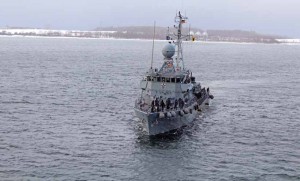
It is a difficult type of warfare, because it is under water and the weather is always influencing us.
It is always a challenge, so nations tend to find the best equipment possible to operate under water.
It used to be the French PAP (Poisson auto-propulsé) developed in the 1960’s.
The German SeaFox, smaller and therefore easier to maœuver, is now used by many nations, because it is an almost autonomous vehicle and one of the best systems available at this time to counter mines.
You can do identification with it, and you can also destroy mines if needed. Each nation however has its own acquisition process and, as an operational commander, I am just very happy to have different options whether in sonars, drones, or else, although logistically speaking, it may not be wise.
The logistic responsibility remains in fact nation-centric.
In case of a breakdown, we will of course check within the Group to see if there are spare parts available, but if something has to be flown in, it is done so under the responsibility of each nation.[ref] The FGS Donau belongs to the Type 404 Elbe class replenishment ships of the German Navy. They were built to support its squadrons of Fast Attack Craft, submarines and minesweeper/hunters and as such are usually referred to as Tenders. They have a deck where Sea Kings or larger helicopter can land, but no hangar.[/ref]
I see our role as supply ship, as a “travel agency,” i.e. organizing the trips and coordinating, so we keep our operational capabilities at the highest level possible.
Every day I find out how much replenishment is needed and we organize what needs to be done.
If something has to be brought in, or if the Commanding Officer of one of the ships needs to go out of the group to port to get some things, we, as a command logistic platform, coordinate all that.
We can also arrange for the MCM mission to continue, while the support platform goes into port to get the spare parts.
We will be eight ships during the course of our deployment, which means more work in coordinating the parts and tasking of the ships.
But it makes the work easier, because the more ships, the more units you have available, the easier the task will be. MCM operations are indeed always about “we don’t have enough time,”
because everybody is always eager to transit somewhere without being stopped by sea mines.
With all the challenges we have with MCM, it takes time to get rid of mines.
So, the more ships we have, the easier the tasking becomes.
Our Netherlands’ MCMVs– which are the same for the Dutch, Belgian and French Navies – were designed jointly by these three nations in the late 70’s and commissioned in the early 80’s.
So they are almost thirty years old.
Our youngest Tripartite-class ship was commissioned in 2000.
When we first build our ships, we are always aiming for twenty- to thirty-year life-cycle, including a mid-life upgrade.
But there is always a part of unpredictability which goes with new equipment.
When the first GRP ships [Glass reinforced polyester] were built in the early 80’s, we did not know whether GRP ships would survive thirty years in salt water.
We are finding out right now that the hulls are still very good.
However, we need to regularly address engineering issues (pipes leaking for instance), as well as system obsolescence, which have sometimes to be fully replaced, as communication and computers for instance become outdated.
These are the challenges we are facing right now, since if something breaks down on the ship, there is no backup and the small ships need to go to port.
We need to ensure that this unit can be safely replaced as we look towards the future.
In that sense, the only recommendation I would have is that all nations try to keep up their level in MCM capacities, whatever it might be, to be prepared to counter mine threats and master such a difficult type of warfare.
What is the current evolution in mines threats precisely as well as in MCMs?
How do you assess innovations regarding the use of unmanned underwater systems?
Our ships are designed to do mine countermeasures, which is not the same as clearing historic ordinance.
Historic ordinance are explosives, which have been lying on the bottom of the sea for a long time.
As long as you do not touch or move them, they are not directly harmful, but the moment you drop your anchor on one of them or try to build a windmill on top of them, then, of course, that is a problem.
To dispose of historic ordinance, however, is not too difficult: you just blow it up and that is what we do on a regular basis: seventy years after WWII, we are still clearing the bottom of the sea with explosives from both WWI and WWII…
Real sea mines on the other hand pose a direct danger to the mine countermeasures vessels (MCMVs), which must therefore be well protected from external signatures like acoustics or magnetic sensors.
They used to be made of wood, but now they are made of Glass reinforced polyester (GRP), which does not influence the magnetic field of the earth.
Our engines are also put on mountings, so they do not transfer the noise into the water.
MCMVs are therefore quite safe.
Modern mines can cause real problems, if they target a specific ship or are intended to deny access to a port, stop traffic or alter a strategy.
A mine-layer should however have quite generic mines (as was the case during the first Gulf war when an American ship was hit).
These are cheap weapons, which can be deployed from any kind of ships.
That is why they are so dangerous, but we can handle them.
Regular sea mines are not difficult weapons to acquire, as they are like IEDs on shore.
The more modern and sophisticated mines are harder to find, as they can be hidden taking for instance the appearance of a rock.
That is also the purpose of the NATO MCM groups: we are, of course, ready to counter any real threat, terrorist or else.
For budgetary priorities, some nations, such as the Netherlands, stopped their minesweepers program a few years ago, but are maintaining their research capability in order to be able to build the right gear if need be.
Keeping a minesweeping capability is very expensive given the complexity of modern mines, and the fact that simulation does not apply easily.
Simulating an actual ship is indeed very hard (vessels filled with ping-pong balls, or filled with foam, have been tried without much success).
These are the reasons why most nations in the past decade or so have been tending to focus essentially on minehunters.
The same goes with the ability to lay mines: only a few nations have kept this capability, but investment in research has been maintained within NATO.
In case of conflict, sea mines have indeed their value, as they allow to deny the enemy access to ports or specific areas.
As far as drones are concerned, one should remember that the environment at sea with its waves, currents, wind, as well as the underwater environment, are constantly changing.
That renders steering and communicating with any systems which you try to use remotely very difficult.
Using such systems from non-protected vessels as some Navies envision it is not totally feasible at this time.
Of course, everybody is researching for fully autonomous robots going into the water and clearing all the mines, but you will always need dedicated MCMV’s and personnel to oversee the mission.
Another solution, which is the Marine mammal program is a good way and is very impressive.[ref] Mostly undergone by the US Navy ever since the Vietnam war, some sources mention a few other nations, such as Russia, using dolphins for MCMs.[/ref]
It is however very expensive and you need people to make sure the job has been done properly.
Going against explosives in the water is a dangerous type of warfare and you need dedicated personnel to do so.
Compared to your past deployments – you mentioned the Arabian Gulf — how would you describe your current area of responsibility in the Northern and Baltic Seas?
There is of course a political dimension to the Baltic region given current events: it is about reassurance and showing that we are here.
We are a Readiness force demonstrating NATO’s resolve.
In terms of HOD, an immense amount of sea mines has been thrown in the Baltic Sea, especially during the Second World War.
So the moment we start the Open Spirit exercise off the coast of Estonia and the moment we will turn on our sonars, we will find explosives.[ref] Open Spirit is an annual HOD multinational exercise conducted since 1996 and led by one of the three Baltic states on a rotational basis.[/ref]
There is a big difference between the North Sea, which I am more used to, and the Baltic Sea.
In the North Sea, we have been using trawlers for fishery for decades, which have found quite a lot of explosives laying on the bottom of the sea.
In the Baltic Sea, there is hardly any trawl fishery and many mines are still there with their explosives intact.
I am therefore just very keen in contributing to the safety of the area we are deploying in.
How are you positioning the SNMCMG1 for the upcoming largest NATO exercise in decades, i.e. Trident Junction 2015 due to start in the Fall in southern Europe?
Is having a Dutch Commander related to the fact that TJ15 will be under a Dutch Joint Command?
Trident Juncture of course is a very large exercise.
I am currently focusing on the first six months of deployments, because most of my units, most of the ships participating in this Group right now will only be here for three to six months.
In July, both my staff and my ships will be changed and the only ones remaining will be the steward and me.
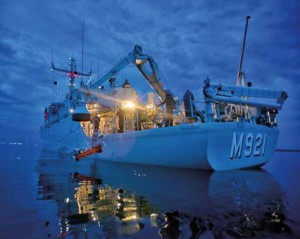
In the second half, we shall probably go around the same procedures again to get used to each other and do basic exercises.
Then we shall indeed work up towards Trident Juncture.
In 2016, the Netherlands Navy will be in command of the Immediate Reaction Force (IRF) and the NMR [Allied Command Operations’ National Military representatives] staff is preparing for it.
Trident Juncture will be a big exercise, during which we will be able to test our capabilities in that respect.
My regular function is being part of the NMR-4 staff working on MCM, a function I have not been relieved from.
Through exercises like Joint Warrior, I can keep my interactions with the NMR-4 staff.
It will also be the case during TJ15, for which an amphibious scenario is planned, so I will try to use the NATO group to fit into this scenario of amphibious warfare.
An amphibious scenario means that you have bigger ships with a lot of troops going through shallow waters which could be mined.
Mine countermeasures is therefore always part of advanced forces operations.
However, because most exercises are limited to one to three weeks, MCM are in practice done in a separate area.
I would like in this case to see a bit more of an operational flow, where you first have MCMs and then continue on with the amphibious landing.
That is something that I would like to train and focus on especially this year.
All this depends on the whole scenario done by the exercise controller.
My staff is called the tasking authority: we order the ships to go to a specific area and do a specific MCM task.
It is our responsibility to organize where the MCM teams are going, and what they are doing in coordination with higher authorities.
That also means doing the calculations about MCM, reporting the percentage clearance or remaining risks for other ships, and then, of course, reporting if we find any mines or not.
What everybody always tends to forget is that MCM is not always to clear the sea mines.
It is also to show whether there are mines or not. Demonstrating the absence of mines is in actual fact perhaps even more important than showing that there are mines.
Being part of advanced forces means that you need to have some intelligence with special forces probably going in.
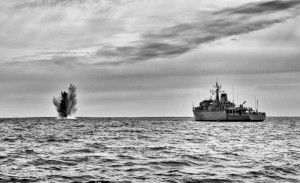
States. Credit: NATO
They are of course well trained to do things unseen.
On the other hand, our ships which go into advanced forces operations are big grey ships which can easily be seen.
These ships are not well equipped for generic warfare: they do not have air warning radars; they do not have heavy weaponry, and are only capable of defending themselves against small attacks (pirates; terrorists…).
We can protect ourselves against individuals coming towards us, not against an air raid or major surface combatants.
We use MCM Protecting Units (MCMPUs), but we would need a frigate or other capable ships to defend the group.
Then we run into the following challenge: how do you get a frigate into a possible minefield?
This is all about strategy and how we are we going to handle these types of scenarios.
That is why I say that it is probably more important to prove the absence of mines than the actual existence of mines.
We have seen it in the early 90’s in the Persian Gulf, where Iraq had laid sea mines.
The initial plan of the Coalition was to conduct a large amphibious operation off the coast of Iraq, but two American ships were hit by sea mines and we knew there were more mines present.
The whole strategy to reach Iraq changed, as we went around the minefield by crossing Kuwait.
This example illustrates how big an influence a sea mine can have on military warfare.
Just one or two sea mines completely altered the strategy underlying that operation.
I believe therefore that, again, showing a way onto the beach, where the mines are absent, is precisely something we have to train more.
Even though we have been discussing this for decades, the short duration of exercises tends to have us focus on the best separate training for MCMVs on the one hand, the frigates on the other hand.
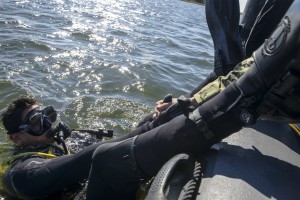
An amphibious operation is about getting all that different types of warfare together and raising many questions.
What are we going to report?
How are we going to talk to each other?
How are we going to defend each other?
How do you get a frigate in a possible minefield?
All these challenges do come up when you put together an amphibious operation.
Amphibious warfare is indeed the most extensive, the most difficult operation you can do.
Trident Juncture will be in that sense a first-rate opportunity for the SNMCMG1 to train and rehearse in this kind of complex context.
Editor’s Note: Murielle Delaporte went to sea with the NATO counter-mine task force and was onboard the German Marine Tender Donau earlier this year.
She is the co-founder of Second Line of Defense and the editor of Operationnels where a complete dossier on the NATO approach to mine warfare is discussed from the standpoint of her time in the Baltic sea operation.
For an article which deals with the possible use of unmanned systems in counter-mine operations see the following:
https://sldinfo.com/“de-platformizing”-the-counter-mine-mission/

